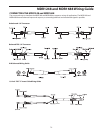
17
Operating the MDR1248 and MDR1688
SENDING AN INDEPENDENT MIX TO THE
MONITOR SPEAKERS
The MDR1248 and MDR1688’s AUX1 auxiliary send can be
used to feed a separate set of amplifiers and loudspeakers
for stage monitors. This lets you build one mono mix for
the amplifiers and monitor speakers facing the musicians,
and the other stereo mix for the amplifiers and speakers
facing the audience.
1. Connect the AUX1 output to your monitor's power
amplifier or powered monitor.
2. Press the input channels’ AUX 1 PRE/POST switches
in, to set AUX 1 up as a pre-fader bus.
3. Raise the AUX SEND 1 control knob, located in the
Master section, up to a little past “5” or halfway.
4. Raise the AUX 1 controls for the channels that you
wish to hear from the monitor speakers.
NOTE: When the AUX1 PRE/POST switch is pressed in and
set to “PRE”, the AUX 1 controls are "PRE-FADER SENDS"
which means they are not affected by the level settings
of each channel. This allows you to create a mix for the
monitor system that is independent of the main LEFT and
RIGHT MIX.
5. If feedback occurs, turn down the AUX SEND 1 knob
to lower the overall level sending to the monitor.
Then check the AUX1 levels of the individual chan-
nels to see if you need to turn one or more channels
down. Then try to raise the AUX 1 SEND level again.
NOTE: Adjusting the balance between the channel AUX1
control knobs and the AUX SEND 1 is a tricky but neces-
sary part of getting good levels in the monitor system. In
general, try to keep the master AUX SEND 1 higher than
the channel AUX1 levels to achieve a cleaner mix. In order
to get the most gain from your monitor mix, use an exter-
nal graphic equalizer (like a Samson S curve 131or D2500
digital EQ with feedback control) to cut out any frequen-
cies that cause feedback.
6. If you want to add effects from the internal effect
processor, or the effects from an external proces-
sor connected to the AUX RETURN 2 inputs, engage
the AUX RETURN 2 TO AUX 1 switch, located in the
Master section, by pressing it in.
USING THE CHANNEL INSERT JACKS
To further control your signal, channels 1-4 on the
MDR1248 and 1-8 on the MDR1688 feature an inser-
tion point, or “effects loop”, on one 1/4-inch phone jack,
INSERT SEND and RETURN. An insertion point is a patch-
point that interrupts the signal, allowing you to bring that
signal outside to be processed by another device. You
can use these connections to interface an external signal
processor like an equalizer, compressor, noise gate, reverb
and other audio devices. A common application for the
MDR1248 and MDR1688’s insert point is using a compres-
sor.
To send a signal to an external processor, use a standard
1/4-inch “Y” insert cable to connect the MDR1248 and
MDR1688 channel insert point. Connect the TRS (TIP /
RING / SLEEVE) plug to the channel INSERT point, and
then, connect the 1/4-inch (TIP / SLEEVE), INSERT SEND
plug to the input of the external processor. The signal is
sent back to the MDR1248 or MDR1688, using the 1/4-
inch (TIP / SLEEVE), INSERT RETURN plug connected to the
output of the external processor.
The diagram below shows a typical application for using a
compressor (in this example a Samson C com opti) in the
MDR1248 or MDR1688’s insertion point.
Below, is a diagram showing the wire for the TRS ‘Y” Insert
cable.


















